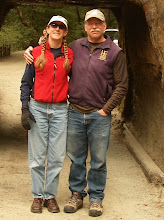The size of some of the pieces was astounding. There were huge columns from Egypt and magnificent gate sculptures that would flank a gate of an Assyrian palace.
One of the special exhibits focussed on the museum's clock collection. It included many unique types of clocks, astronomical and regular, and the chronometer of the Beagle, the ship that Darwin sailed on. He wrote a book about his voyage on the Beagle and the experience was critical to his development of the theory of evolution.
Monday was our last day of sightseeing and we started at St. Paul's cathedral, the architectural masterpiece of Christopher Wren.
It is an amazing cathedral and an icon in London. Our bus tour guide on Friday told us that his mum would come out after a bombing raid during the Blitz and would look for St. Paul's. If it was standing then everything was all right. The Germans tried to destroy St. Paul's and Buckingham palace. They managed to destroy the chapel of Buckingham palace, but the wood dome of St. Paul's was untouched.
We climbed all 528 stairs to the Golden gallery above the dome.
No pictures were allowed inside so we can't show you the beautiful mosaics inside the transept or the frescoes in the dome. St. Paul's is the final resting place for the two most famous men in British military history, Lord Nelson and the Duke of Wellington. Their sumptuous caskets are on display in the crypt. This is the first cathedral we've visited with so many memorials to warriors (from the navy and the army). The final piece of history of the day
was the Tower of London.
William the Conquerer built the White Tower which is in the center of the Tower grounds. Later monarchs built additional fortifications and towers that ring the White Tower.
The Tower was the place of royal beheadings during the reign of Henry VIII and is the repository of the crown jewels. However, it's main role over the ages has been an armory. It has an amazing collection of armor including three sets of armor for Henry VIII and an amazing collection of cannons and guns.
In the old days the monarchs kept a menagerie of animals on the grounds. Today those animals are represented by very life like sculptures done in chicken wire.
There has always been a flock of ravens living at the Tower. Legend has it that if the ravens leave the Tower, the Tower and England will fall. These days the future of England is insured because the ravens wings are clipped.
Well.. Great Britain's end won't come until the ravens fly from the Tower of London, but our journey is at it's end. Tuesday we load boxed bikes and baggage on a plane and fly home. It has been a great trip and we are a little sad for it to end. However, we are somewhat homesick and are looking forward to be back with friends and family. We give a special thanks to everyone who has joined us through our blog and to those new friends we have made on the way. Love to all!
